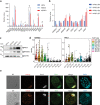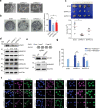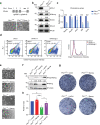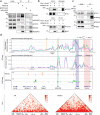PHC1 maintains pluripotency by organizing genome-wide chromatin interactions of the Nanog locus
- PMID: 33990559
- PMCID: PMC8121881
- DOI: 10.1038/s41467-021-22871-0
PHC1 maintains pluripotency by organizing genome-wide chromatin interactions of the Nanog locus
Abstract
Polycomb group (PcG) proteins maintain cell identity by repressing gene expression during development. Surprisingly, emerging studies have recently reported that a number of PcG proteins directly activate gene expression during cell fate determination process. However, the mechanisms by which they direct gene activation in pluripotency remain poorly understood. Here, we show that Phc1, a subunit of canonical polycomb repressive complex 1 (cPRC1), can exert its function in pluripotency maintenance via a PRC1-independent activation of Nanog. Ablation of Phc1 reduces the expression of Nanog and overexpression of Nanog partially rescues impaired pluripotency caused by Phc1 depletion. We find that Phc1 interacts with Nanog and activates Nanog transcription by stabilizing the genome-wide chromatin interactions of the Nanog locus. This adds to the already known canonical function of PRC1 in pluripotency maintenance via a PRC1-dependent repression of differentiation genes. Overall, our study reveals a function of Phc1 to activate Nanog transcription through regulating chromatin architecture and proposes a paradigm for PcG proteins to maintain pluripotency.
Conflict of interest statement
The authors declare no competing interests.
Figures






Similar articles
-
Polycomb Group Protein Pcgf6 Acts as a Master Regulator to Maintain Embryonic Stem Cell Identity.Sci Rep. 2016 Jun 1;6:26899. doi: 10.1038/srep26899. Sci Rep. 2016. PMID: 27247273 Free PMC article.
-
PRC2 specifies ectoderm lineages and maintains pluripotency in primed but not naïve ESCs.Nat Commun. 2017 Sep 22;8(1):672. doi: 10.1038/s41467-017-00668-4. Nat Commun. 2017. PMID: 28939884 Free PMC article.
-
PCGF6 regulates stem cell pluripotency as a transcription activator via super-enhancer dependent chromatin interactions.Protein Cell. 2019 Oct;10(10):709-725. doi: 10.1007/s13238-019-0629-9. Epub 2019 Apr 30. Protein Cell. 2019. PMID: 31041782 Free PMC article.
-
The polycomb group protein Yaf2 regulates the pluripotency of embryonic stem cells in a phosphorylation-dependent manner.J Biol Chem. 2018 Aug 17;293(33):12793-12804. doi: 10.1074/jbc.RA118.003299. Epub 2018 Jun 29. J Biol Chem. 2018. PMID: 29959227 Free PMC article.
-
PRC1 and PRC2 proximal interactome in mouse embryonic stem cells.Cell Rep. 2025 Mar 25;44(3):115362. doi: 10.1016/j.celrep.2025.115362. Epub 2025 Mar 5. Cell Rep. 2025. PMID: 40053453
Cited by
-
Aptamers for Addressed Boron Delivery in BNCT: Effect of Boron Cluster Attachment Site on Functional Activity.Int J Mol Sci. 2022 Dec 24;24(1):306. doi: 10.3390/ijms24010306. Int J Mol Sci. 2022. PMID: 36613750 Free PMC article.
-
Acquisition of neural fate by combination of BMP blockade and chromatin modification.iScience. 2023 Sep 9;26(10):107887. doi: 10.1016/j.isci.2023.107887. eCollection 2023 Oct 20. iScience. 2023. PMID: 37771660 Free PMC article.
-
CBX7C⋅PHC2 interaction facilitates PRC1 assembly and modulates its phase separation properties.iScience. 2024 Mar 21;27(4):109548. doi: 10.1016/j.isci.2024.109548. eCollection 2024 Apr 19. iScience. 2024. PMID: 38600974 Free PMC article.
-
Thymoquinone-Mediated Modulation of Toll-like Receptors and Pluripotency Factors in Gingival Mesenchymal Stem/Progenitor Cells.Cells. 2022 Apr 25;11(9):1452. doi: 10.3390/cells11091452. Cells. 2022. PMID: 35563755 Free PMC article.
-
USP7 represses lineage differentiation genes in mouse embryonic stem cells by both catalytic and noncatalytic activities.Sci Adv. 2023 May 19;9(20):eade3888. doi: 10.1126/sciadv.ade3888. Epub 2023 May 17. Sci Adv. 2023. PMID: 37196079 Free PMC article.
References
Publication types
MeSH terms
Substances
LinkOut - more resources
Full Text Sources
Other Literature Sources
Molecular Biology Databases
Research Materials

